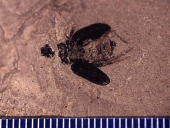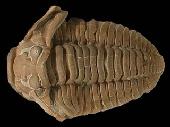|
 See More Images See More Images

Carabidae
© 1998 UCMP

Diptera
© 2005 The Virtual Fossil Museum

Flexicalymene meeki
© 2004 Michigan State University Museum
|
What are Arthropods? Arthropods, meaning “jointed foot,” get their name because they have a segmented, jointed external skeleton made primarily of chitin, which is often further stiffened with calcium carbonate. As arthropods grow, they must break apart and remove this old skeleton and form a new one by molting. Different arthropod groups have appendages that have been modified for different purposes, such as sensory functions, respiration, feeding, and locomotion. Arthropods include the most numerous and diverse group of animals today, the insects, as well as shrimp, spiders, millipedes, and barnacles. Also included are many extinct forms, like trilobites and eurypterids. First known fossil occurrence: Cambrian. Last known fossil occurrence: Quaternary. This group has living relatives. |
Fossils through time:
Choose a time period to see what life was like:
|
|